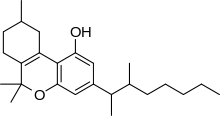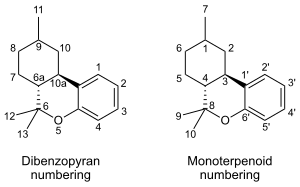Dimethylheptylpyran
Dimethylheptylpyran (DMHP, 3-(1,2-dimethylheptyl)-Δ6a(10a)-THC, 1,2-dimethylheptyl-Δ3THC, A-40824, or EA-2233) is a synthetic analog of THC, which was invented in 1949 during attempts to elucidate the structure of Δ9-THC, one of the active components of Cannabis.[1] DMHP is a pale yellow, viscous oil which is insoluble in water, but dissolves in alcohol or non-polar solvents.
 | |
| Clinical data | |
|---|---|
| ATC code |
|
| Legal status | |
| Legal status |
|
| Pharmacokinetic data | |
| Elimination half-life | 20–39 hours |
| Identifiers | |
IUPAC name
| |
| CAS Number | |
| PubChem CID | |
| ChemSpider | |
| UNII | |
| ChEMBL | |
| Chemical and physical data | |
| Formula | C25H38O2 |
| Molar mass | 370.577 g·mol−1 |
| 3D model (JSmol) | |
SMILES
| |
InChI
| |
| | |
Effects
DMHP is similar in structure to THC, differing only in the position of one double bond, and the replacement of the 3-pentyl chain with a 3-(1,2-dimethylheptyl) chain.[2] It produces similar activity to THC, such as sedative effects, but is considerably more potent,[3] especially having much stronger analgesic and anticonvulsant effects than THC, although comparatively weaker psychological effects. It is thought to act as a CB1 agonist, in a similar manner to other cannabinoid derivatives.[4]
Investigation as non-lethal incapacitating agent
DMHP and its O-acetate ester were extensively investigated by the US military chemical weapons program in the Edgewood Arsenal experiments, as possible non-lethal incapacitating agents.[5]
DMHP has three stereocenters and consequently has eight possible stereoisomers, which differ considerably in potency. The mixture of all eight isomers of the O-acetyl ester was given the code number EA-2233, with the eight individual isomers numbered EA-2233-1 through EA-2233-8. The most potent isomer was EA-2233-2, with an active dose range in humans of 0.5–2.8 μg/kg (i.e. ~35–200 μg for a 70 kg adult). Active doses varied markedly between individuals, but when the dose of EA-2233 was taken up to 1–2 mg, all volunteers were considered to be incapable of performing military duties, with the effects lasting as long as 2–3 days.
DMHP is metabolised in a similar manner to THC, producing the active metabolite 11-hydroxy-DMHP, but the lipophilicity of DMHP is even higher than that of THC itself, giving it a long duration of action and an extended half-life in the body of between 20 and 39 hours, with the half-life of the 11-hydroxy-DMHP metabolite being longer than 48 hours.
DMHP and its esters produce sedation and mild hallucinogenic effects similar to large doses of THC, but in addition to this they also cause pronounced hypotension (low blood pressure) which occurs at doses well below the hallucinogenic dose, and can lead to severe dizziness, fainting, ataxia and muscle weakness, sufficient to make it difficult to stand upright or carry out any kind of vigorous physical activity. The acute toxicity of DMHP was found to be low in both human and animal studies, with the therapeutic index measured as a|ratio of ED50 to LD50 in animals being around 2000 times, with death ultimately resulting from a combination of hypotension and hypothermia and preventable with supportive treatment.
The combination of strong incapacitating effects and a favourable safety margin led the Edgewood Arsenal team to conclude that DMHP and its derivatives, especially the O-acetyl ester of the most active isomer, EA-2233-2, were among the more promising non-lethal incapacitating agents to come out of their research program. However they were disadvantaged by producing severe hypotension at incapacitating doses, and were not as effective as the more widely publicised anticholinergic agents such as 3-Quinuclidinyl benzilate which had also already been weaponised.[6] Funding for continued development was ultimately not approved, and the cannabinoid research program was indefinitely suspended along with the rest of the Edgewood Arsenal experiments in the late 1970s.
Isomerism

| 7 double bond isomers of dimethylheptylpyran and their 120 stereoisomers | |||||||||
|---|---|---|---|---|---|---|---|---|---|
| Dibenzopyran numbering | Monoterpenoid numbering | Additional chiral centers on side chain | Number of stereoisomers | Natural occurrence | Convention on Psychotropic Substances Schedule | ||||
| Short name | Chiral centers in dibenzopyran backbone | Full name | Short name | Chiral centers in dibenzopyran backbone | 1,2-dimethylheptyl numbering | 3-methyloctan-2-yl numbering | |||
| Δ6a(7)-DMHP | 9 and 10a | 3-(1,2-dimethylheptyl)-8,9,10,10a-tetrahydro-6,6,9-trimethyl-6H-dibenzo[b,d]pyran-1-ol | Δ4-DMHP | 1 and 3 | 1 and 2 | 2 and 3 | 16 | No | unscheduled |
| Δ7-DMHP | 6a, 9 and 10a | 3-(1,2-dimethylheptyl)-6a,9,10,10a-tetrahydro-6,6,9-trimethyl-6H-dibenzo[b,d]pyran-1-ol | Δ5-DMHP | 1, 3 and 4 | 1 and 2 | 2 and 3 | 32 | No | unscheduled |
| Δ8-DMHP | 6a and 10a | 3-(1,2-dimethylheptyl)-6a,7,10,10a-tetrahydro-6,6,9-trimethyl-6H-dibenzo[b,d]pyran-1-ol | Δ6-DMHP | 3 and 4 | 1 and 2 | 2 and 3 | 16 | No | unscheduled |
| Δ9,11-DMHP | 6a and 10a | 3-(1,2-dimethylheptyl)-6a,7,8,9,10,10a-hexahydro-6,6-dimethyl-9-methylene-6H-dibenzo[b,d]pyran-1-ol | Δ1(7)-DMHP | 3 and 4 | 1 and 2 | 2 and 3 | 16 | No | unscheduled |
| Δ9-DMHP | 6a and 10a | 3-(1,2-dimethylheptyl)-6a,7,8,10a-tetrahydro-6,6,9-trimethyl-6H-dibenzo[b,d]pyran-1-ol | Δ1-DMHP | 3 and 4 | 1 and 2 | 2 and 3 | 16 | No | unscheduled |
| Δ10-DMHP | 6a and 9 | 3-(1,2-dimethylheptyl)-6a,7,8,9-tetrahydro-6,6,9-trimethyl-6H-dibenzo[b,d]pyran-1-ol | Δ2-DMHP | 1 and 4 | 1 and 2 | 2 and 3 | 16 | No | unscheduled |
| Δ6a(10a)-DMHP | 9 | 3-(1,2-dimethylheptyl)-7,8,9,10-tetrahydro-6,6,9-trimethyl-6H-dibenzo[b,d]pyran-1-ol | Δ3-DMHP | 1 | 1 and 2 | 2 and 3 | 8 | No | Schedule I |
Note that 6H-dibenzo[b,d]pyran-1-ol is the same as 6H-benzo[c]chromen-1-ol.
References
- Adams R, Harfenist M, Loewe S (1949). "New Analogs of Tetrahydrocannabinol. XIX". Journal of the American Chemical Society. 71 (5): 1624. doi:10.1021/ja01173a023.
- Razdan RK (1980). "The Total Synthesis of Cannabinoids". Total Synthesis of Natural Products, Volume 4 (PDF). Wiley-Interscience. doi:10.1002/9780470129678.ch2. ISBN 9780471054603.
- Wilkison, DM; Pontzer, N; Hosko, MJ (1982). "Slowing of cortical somatosensory evoked activity by Δ9-tetrahydrocannabinol and dimethylheptylpyran in α-chloralose-anesthetized cats". Neuropharmacology. 21 (7): 705–9. doi:10.1016/0028-3908(82)90014-4. PMID 6289158.
- Parker, LA; Mechoulam, R (2003). "Cannabinoid agonists and antagonists modulate lithium-induced conditioned gaping in rats". Integrative Physiological and Behavioral Science. 38 (2): 133–45. doi:10.1007/BF02688831. PMID 14527182.
- Possible Long-Term Health Effects of Short-Term Exposure To Chemical Agents. Vol. 2: Cholinesterase Reactivators, Psychochemicals and Irritants and Vesicants. Commission on Life Sciences. The National Academies Press. 1984. pp. 79–99.
- Ketchum, James S. (2006). Chemical Warfare Secrets Almost Forgotten. ChemBooks Inc. ISBN 978-1-4243-0080-8.